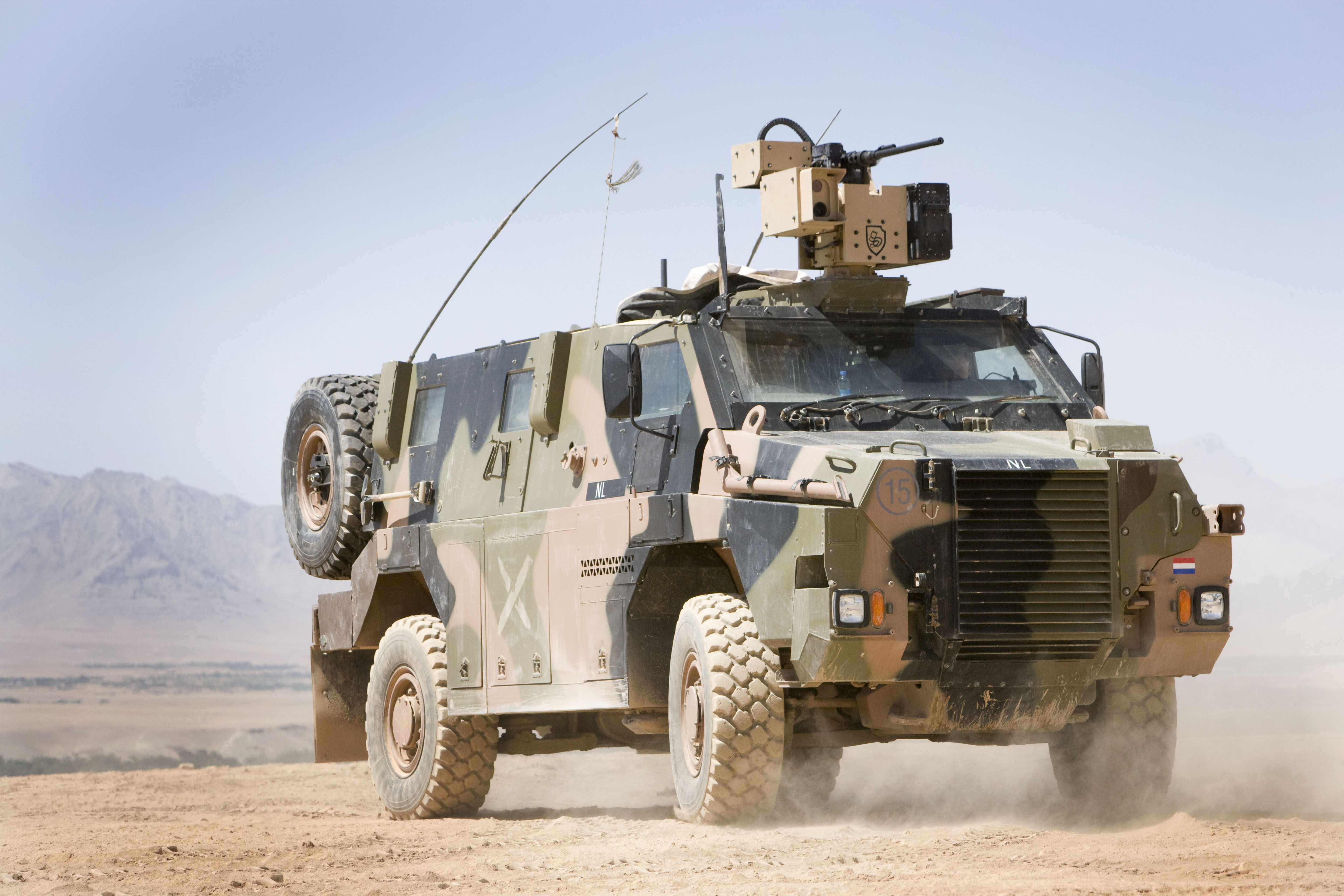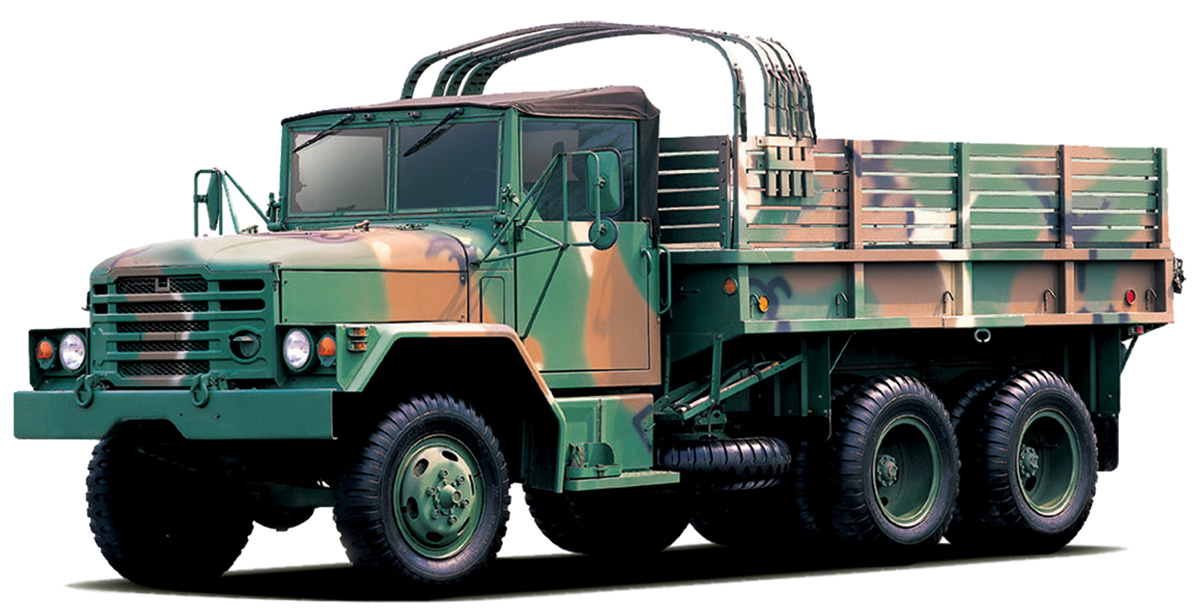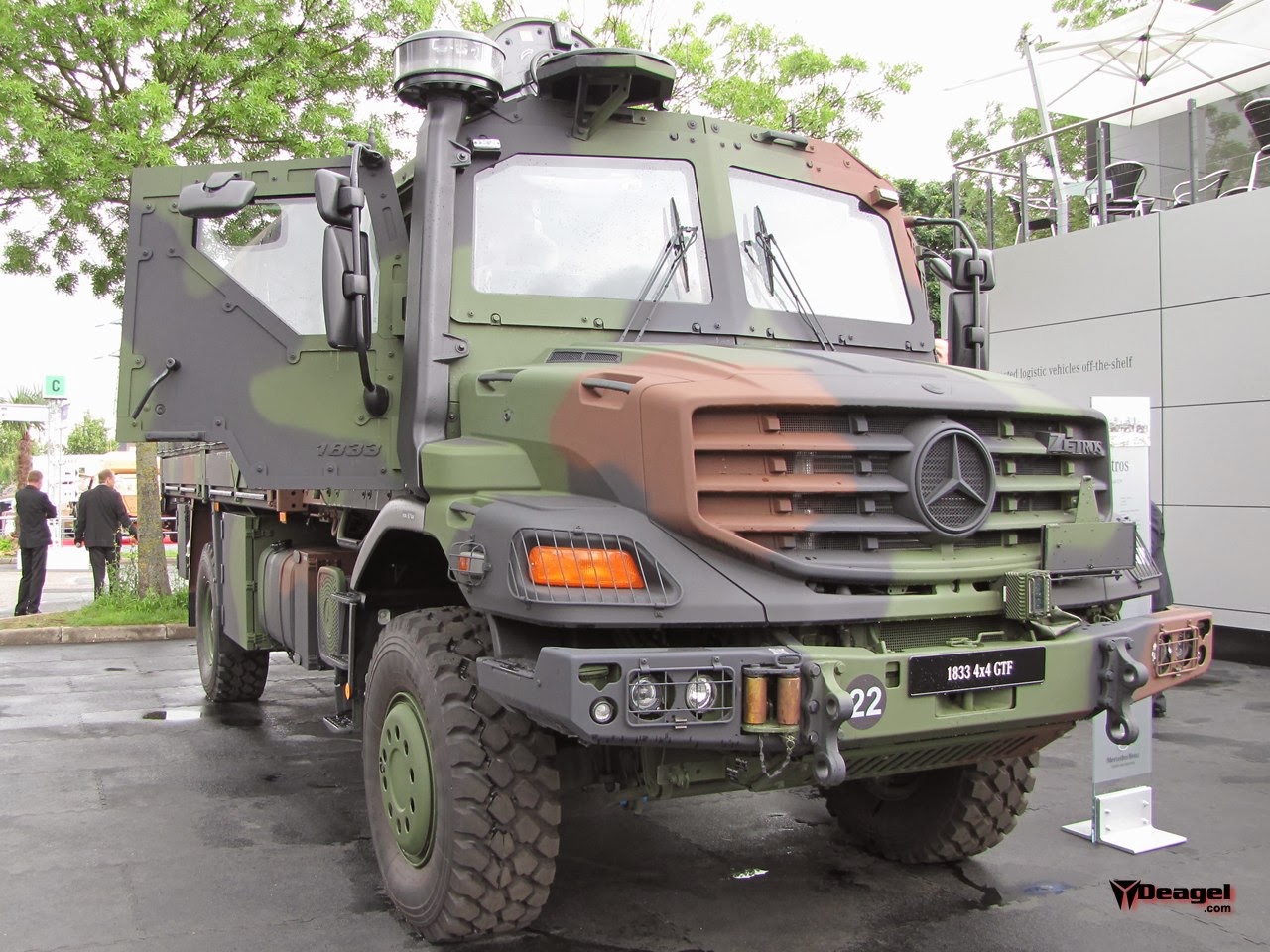Cargo haulage has throughout the years
relied very much on the hardy utility truck. Despite the fact that they are
mainly designed for commercial cargo transport, these trucks too have been
developed with soldiers’ transportation in mind, resulting in inter-changeable
configurations that allow these workhorses to execute multiple duties while at
the same time ensuring armed forces’ sustainability in hostile settings.Capable of hauling supplies for hundreds
of kilometres, these trucks also have the ability to endure journeys in
impermissible environments. In order to operate in risky conditions, all
manufacturers have provided these trucks with sufficient measures such as
reinforced armoury and gunnery for protection against exterior threats. These
trucks are armoured not only to protect the supplies being delivered, but also
the most valued asset of any armed forces - the soldiers themselves.
Through evolution and revolution, since
the great battle of World War II till the days of Operation Freedom in Iraq,
from the inhospitable Afghanistan desert to the jungles of the South East Asia,
utility trucks have been a major element in the formation of dominant armed
forces. ASPAC Defence delivers some outlook and updates on a number of military
utility trucks currently active and in service all around the world.
Thales Bushmaster
The
Australian Army has originally selected the Bushmaster by Thales Australia
after a series of trials in 1998. The development programme was initiated as an
effort to fulfil the requirements of the Bushranger, a Thales Australia
flagship project that has been progressing since the last two decades.
Throughout the period, Thales Australia has come up with multiple variants of
their Bushmaster product, ranging from ambulance, troop carrier, IED
interrogator, command post as well as for utility purposes.
The
Bushmaster Utility Single Cab is a member of the 4x4 Bushmaster series offered
by Thales Australia specifically meant for logistic purposes. Weighing 11.5
tonnes, the truck was designed for logistic operations in very hostile
environments. It has a generously high payload, able to fit and transport up to
5.7 tonnes of supply thanks to the large cargo space provided.
The
Utility Single Cab variant of the Bushmaster is equipped with the Cummins ISBe
300 diesel engine, producing 300hp and up to 1100Nm of torque, powerful enough
for all-terrain operations. Additionally, the truck is fitted out with a fuel
tank with a 300-litre capacity, providing enough fuel for a maximum range of
800km. In a situation where the truck is fully loaded, it can at its best,
cruise at a maximum speed of 100km/h, allowing for a speedy supplies delivery
during operations.
The
Bushmaster series, having been operational for the past 15 years, has served
effectively in various battles and operations, including in East Timor, Afghanistan
as well as in Iraq. The Bushmaster is currently serving a number of armed
forces, namely the Royal Australian Army, the Royal Netherlands Army as well as
the Royal British Army.
Oshkosh MTVR Short Bed Cargo
Ohskosh Defense is an American manufacturer
of wheeled tactical vehicles and through their 90 years of experience has come
up with numerous products, which have been serving many armed forces, mainly
the US Army. Oshkosh Defense has established the Medium Vehicle Tactical
Replacement (MTVR) line, a series of 4x4 and 6x6 trucks under the MTVR category
that consists of trucks built to perform different roles. These trucks include
MK23 and MK25 Standard Cargo Truck, MK27 and MK28 Extended Cargo Truck, MK29
and MK30 Dump Truck, MK37 HIMARS Re-supply Vehicle, MK31 Tractor as well as a
few other variants. In the logistic support category, Oshkosh has introduced
the MTVR 4x4 Short Bed Cargo, a utility truck designed for all-terrain cargo
transportation aimed to fulfil the demands of reliable workhorses by armed
forces operations worldwide.
Caterpillar was awarded with engine
supply procurement and they equipped the MTVR with the C9 diesel engine,
generating 400hp and a maximum torque of 1206Nm. The truck, weighing
approximately 9.8 tonnes, is able to cruise at up to 105km/h on normal roads.
Oshkosh has provided the truck with a reasonably large cargo area, able to
accommodate and transport supplies of up to 9.4 tonnes.
Presently operational with the US Marine
Corps as well as the US Navy, MTVR Short Bed Cargo has proven its capability in
various missions, thanks to the effective package offered by Oshkosh Defense.
Powered by the Caterpillar C9 engine, plus a large 295-litre fuel capacity, the
truck has a maximum range of 493 km, suitable for medium range tactical
missions.
Mercedes Unimog U4000
The Unimog series from Mercedes Benz have
been around since 1940s, designed and manufactured for commercial as well as
military purposes. Easily noticeable by its high build up, the Unimog is a 4x4
multi-purpose utility truck with an advanced frame and suspension integration
thus the high ground clearance. For military purposes, Mercedes has introduced
the U4000 model, a 32-speed truck readily available to endeavour journeys,
delivering supplies in almost any kind of environment.
Weighing four tonnes, at the heart of the
truck is the 177hp OM904 diesel engine, producing 675Nm of torque and a maximum
speed of 102km/h, which suits the truck’s light configuration. The truck is
equipped with a fuel tank of 145-litre capacity, providing enough fuel supply
for a journey of 760km.
Despite the fact that the Unimog U4000 is
an all-terrain utility vehicle, the high build up configuration has resulted in
the payload capacity limitation at only 4.5 tonnes. This limitation was set to
ensure the vehicle capability to venture into very rough terrain normally
avoided by other trucks. Therefore it is no surprise that these trucks can be
found in jungles, deserts and mountains, performing diverse roles including
fire fighting, scientific expedition as well as other critical military roles.
Renault Sherpa 5
Made available in 2004, the Sherpa 5
truck by Renault is currently active with various armed forces all over the
world. Available in 4x4 and 6x6 configuration, Renault has retrofitted the
truck with the MD-7 diesel powered engine, which is capable of producing 1050Nm
of torque as well as 290hp. Compared to its competitors, the Sherpa 5 has a
considerable high torque. This, according to Renault is to enable the truck to
endeavour into harsh settings, which normally do not permit sufficient
mobility.
Equipped with a 215-litre fuel tank, the
truck can travel to a destination as far as 800km, with a maximum speed of
90km/h. With a weight approximately 7.3 tonnes, the truck has a payload of 6.7
tonnes, capable of delivering multiple types of supplies including armaments as
well as soldiers. The truck too, was designed with inter-changeable
configurations that allow it to perform multiple roles. Meanwhile, Renault has
come up with crew protection measures including armoured
doors, floor, roof and windscreen.
KIA KM250
The
KM250 truck by KIA Motors is essentially an updated version of the famous
US-made M35A2 truck. While retaining the classic American look of long bonnet,
soft-topped cab and a large carrying area, KIA has integrated the truck with
several modern features. Powered by the 180hp KK-7.4 diesel engine, the truck
is capable of cruising at 95km/h with torque generation recorded to as much as
490Nm.
Weighing
6.1 tonnes, the truck, designed with 6x6 configuration, is equipped with a fuel
tank, with a capacity of 200 litres of fuel. Though the KM250 is a relatively
small scale in the logistic truck category, it is capable of transporting
supplies weighing up to 4.5 tonnes on hard surface while for off-road
transportation, the truck is able to transport 2.3 tonnes of supplies,
delivering heavy loads including food supplies, armaments as well as fully
equipped soldiers. In troop transport configuration, the truck can carry as
many as 20, plus the crew of two.
Despite
the fact that the truck produces quite a low torque, the 200-litre tank
capacity replaces the payload limitation by enabling the vehicle to reach a
destination as far as 955km. Currently in service with the Republic of Korea
Army and the Philippine Army, the KM250 truck is also available in several
variants including the KM250 itself as a cargo truck, KM251 (cargo truck with extended
wheelbase), KM255 (fuel tanker), KM256 (water tanker), KM258 (shop van) as well
as the KM259 model (decontamination truck).
TATA LPTA 1623
As the biggest vehicle manufacturer in
India, Tata Motors has been producing almost all kinds of vehicle, be it for
commercial or military purposes. Having been mass-producing vehicles ranging
from cars, busses and trucks, Tata has also fulfilled India’s military demands
by supplying numerous kinds of land vehicles focusing on logistics support.
Tata has produced various logistic trucks and one of the latest in their
productions is the 4x4 LPTA 1623 model.
Like any other trucks, the LPTA 1623 was
developed with the consideration of fulfilling the needs of the armed forces.
Despite the fact that the truck was mainly applicable for military use, it is
also capable of executing variety of operations including fire fighting,
emergency as well as acting as recovery vehicles.
Weighing approximately 7.5 tonnes, at the
heart of the truck is a CUMMINS ISBe 6.7 diesel engine, which is able to
produce 230hp and up to 900Nm of torque. The capability of generating such high
torque is important in enabling the truck to perform tasks in very difficult
environments.
The truck is integrated with a 300-litre
fuel tank thus the supply of enough fuel for a journey of more than 500km.
Built with a reasonably large cargo area, the truck is able to carry payloads
weighing 5 tonnes, with a top speed of 90km/h, thanks to the powerful engine
and high capacity fuel tank retrofitted onto the truck.
Last year, Tata has announced the
cooperation agreement on the development of their trucks with Deftech, a
Malaysian firm in promoting its trucks for the Malaysian Armed Forces. In April last year, Tata Motors and Deftech have agreed to develop two of Tata’s trucks,
the LPTA 1623 and the LPTA 715.
Renault Sherpa 10
Apart from the Sherpa 5 truck, Renault
has also introduced its big brother, built to handle heavier loads, the Sherpa
10. Fitted with a protective cab against ballistic and mine threats, the truck
is currently in service with the French Army, mainly assigned on ammunition
supply roles as well as acting as a self-propelled howitzer platform.
Weighing slightly more than the Sherpa 5,
at 7.8 tonnes, the truck is available in4x4 and 6x6 configuration with a
payload of up to 12 tonnes. Other than the ammunition supply and howitzer
platform role, the truck is also able to transport 18 fully equipped soldiers
thanks to the large carrier bay. In addition to that, Renault has also equipped
the truck with an MD-7 diesel engine, similar to the one equipped onto the
Sherpa 5, but with a higher horsepower as well as torque.
The engine, producing340hp as well as
1306Nm of torque, is easily available and ready for all-terrain supply delivery
missions. Fully loaded, cruising on a hard surface, the truck has a maximum
speed of 90km/h. Fitted with a 310-litre fuel tank, the truck is able to
execute long distance operations measuring to 1000km.
Mercedes Zetros
Introduced in
2008, the Zetros is a truck offered by the Mercedes Benz Military as an upscale
version of the Unimog series. Offered in 4x4 and 6x6 configuration, the Zetros
truck is made available for heavier military logistic operations with a
performance comparable to the Unimog series.
Weighing 6.5 tonnes,
the truck was designed with a large cargo area, which can accommodate supplies
ranging from four to six tonnes. To power the truck, Mercedes has decided to
equip the vehicle with an OM926 LA diesel engine capable of producing 326hp and
generating up to 1300Nm of torque. Fitted with a 300-litre capacity fuel tank,
the truck is capable of travelling more than 500km, with a top speed of 89km/h.
As a safety
measure, the truck is built with an optional armoured cab, providing resistance
against ballistic and mine threats. Since the truck is built with a balanced
load distribution thanks to the cab behind engine design, a swift handling is
made possible and this, in a bigger picture also allows the truck to go through
armoury upgrades without compromising its off-road characteristics and
capabilities.
Oshkosh FMTV
Cargo
Available in 4x4
and 6x6 configuration, the Oshkosh FMTV, which stands for Family of Medium
Tactical Vehicles is widely utilised within the US Army, performing multiple
high-risk tactical as well as logistic missions. Despite the fact that a medium
sized truck has very limited logistic capabilities, the ability to venture into
rough terrains, combined with its payload capacity has made it the vehicle of
choice by most armed forces.
The FMTV Cargo
truck weighs approximately 10.3 tonnes. Powered by a Caterpillar C7 diesel
engine, Oshkosh has also integrated the truck with a 212-litre capacity fuel
tank. The engine, capable of producing 705Nm of torque and 425hp, is also able
to support a fully loaded truck for a journey as far as 483km, fully utilising
the fuel capacity provided onto the truck. In addition to that, the truck can
also cruise at a maximum speed of 89km/h thanks to the efficient engine fitted
onto the vehicle.
The FMTV family
of trucks, other than the cargo version, is also available in multiple variants
including the 5-tonne Tractor, 8.8-tonne Loading Handling System truck,
10-tonne Dump truck as well as the 5-tonne Wrecker. In 2011, the US Army
heralded a procurement initiative with the order of 7000 units of the FMTV
trucks making the total order of 26000 units.
Mowag Duro
With 4000 units
currently in service today, the Duro truck by Mowag was developed to deliver
the demands of armed forces worldwide. Provided with TORSEN self-locking
differential, the truck provides operators with great mobility for on-road and
off-road mission execution. The truck is able in 4x4 and 6x6 configuration,
allowing decision-makers to opt for a suitable truck to suit their armed
forces’ demand.
Weighing 4.8
tonnes, the Duro truck is equipped with a 242hp Cummins ISB 6.7 diesel powered
engine, which is able to generate up to 925Nm of torque. Along with a 180-litre
capacity fuel tank, the truck can deliver supplies to a destination as far as
650km with a top speed average of 100km/h. Thanks to the large cargo area
provided, the truck, for hard surface operation is capable of transporting
supplies weighing approximately 4.2 tonnes.
Apart from being
a logistic truck, the Duro since its introduction has served in many
operations, playing multiple roles including troop transporters, ambulance,
mobile C3 stations, weapon tractors as well as acting as an Explosive Ordnance
Disposal (EOD) vehicle.
Tatra T810
A Czech Republic
company, Tatra has a very long history of the supply of military trucks for
many armed forces. In order to fulfil the Czech Army demand of replacing their
aging Praga truck fleet, Tatra has came up with the T810 model, with a
conventional frame unlike many other Tatra’s truck which normally designed with
non-ordinary physical outlook.
Designed in 6x6
configuration, the truck is at its heart powered by a Renault Dxi7 diesel
engine, which produces 237hp and a maximum torque of 1000Nm. The engine, at its
highest power capacity is able to generate enough power to enable the 8.5-tonne
truck to cruise at a top speed of 106km/h. Furthermore, fitted with a 220-litre
capacity fuel tank, the truck is capable of executing operations to a range as
far as 800km with a payload of 4.5 tonnes.
In order to enhance
military operations capabilities, Tatra has also equipped the T810 truck with a
number of features including optional armoury against ballistic and mine
threats as well as a modified roof for gun carriage system.
MAN TG Series
As a German
corporation known for producing commercial vehicles including trucks and
busses, MAN too involves in the demanding defence industry. Supplying numerous
types of military vehicles, they are mostly acknowledged with the production of
high quality and high reliability military trucks. Looking a few years back,
they came up with the TG series trucks comprising of several models including
the TGL, TGM as well as the TGS model.
The TGL series
truck was designed to fulfil the demand of light-medium military trucks category.
Available only in 4x2 configuration, MAN offers the truck in two variants, the
7.5-tonne for 8-tonne category and 10-tonne for the 12-tonne category. On the
7.5-tonne variant, the truck is equipped with a 150hp Common Rail engine, which
is able to generate as much as 700Nm of torque and a top speed of greater than
100km/h. Fitted with a fuel tank with 150-litre capacity, the truck is able to
deliver supplies within a range of more than 500km.
Meanwhile, the
TGM series offers a wider option for armed forces alike, with the introduction
of 13-tonne, 15-tonne, 18-tonne, 22-tonne and lastly the 26-tonne trucks.
Available in 4x4, 6x2 and 6x4 configuration, the TGM series provides operators
with a superior capability in the transportation of heavier cargo. The TGM
series of trucks are equipped with engines with higher power, ranging from
250hp to 340hp, with bigger fuel tank as well as greater range as compared to
the TGL series.





.jpg)



























